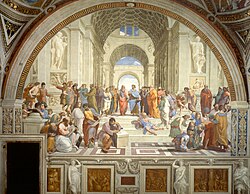
Back عصر النهضة في الأراضي المنخفضة Arabic Nizozemská renesance Czech Renesanco en la Nederlandoj Esperanto Renaissance in de Nederlanden Dutch Renascimento nos Países Baixos Portuguese Renesansa u nizozemskim zemljama Serbo-Croatian Renesansa v Nizozemskih deželah Slovenian
| Renaissance |
|---|
 |
| Aspects |
| Regions |
| History and study |
The Renaissance in the Low Countries was a cultural period in the Northern Renaissance that took place in around the 16th century in the Low Countries (corresponding to modern-day Belgium, the Netherlands and French Flanders).
Culture in the Low Countries at the end of the 15th century was influenced by the Italian Renaissance, through trade via Bruges, which made Flanders wealthy. Its nobles commissioned artists who became known across Europe. In science, the anatomist Andreas Vesalius led the way; in cartography, Gerardus Mercator's map assisted explorers and navigators. In art, Dutch and Flemish Renaissance painting went from the strange work of Hieronymus Bosch to the everyday life of Pieter Brueghel the Elder. In architecture, music and literature too, the culture of the Low Countries moved into the Renaissance style.